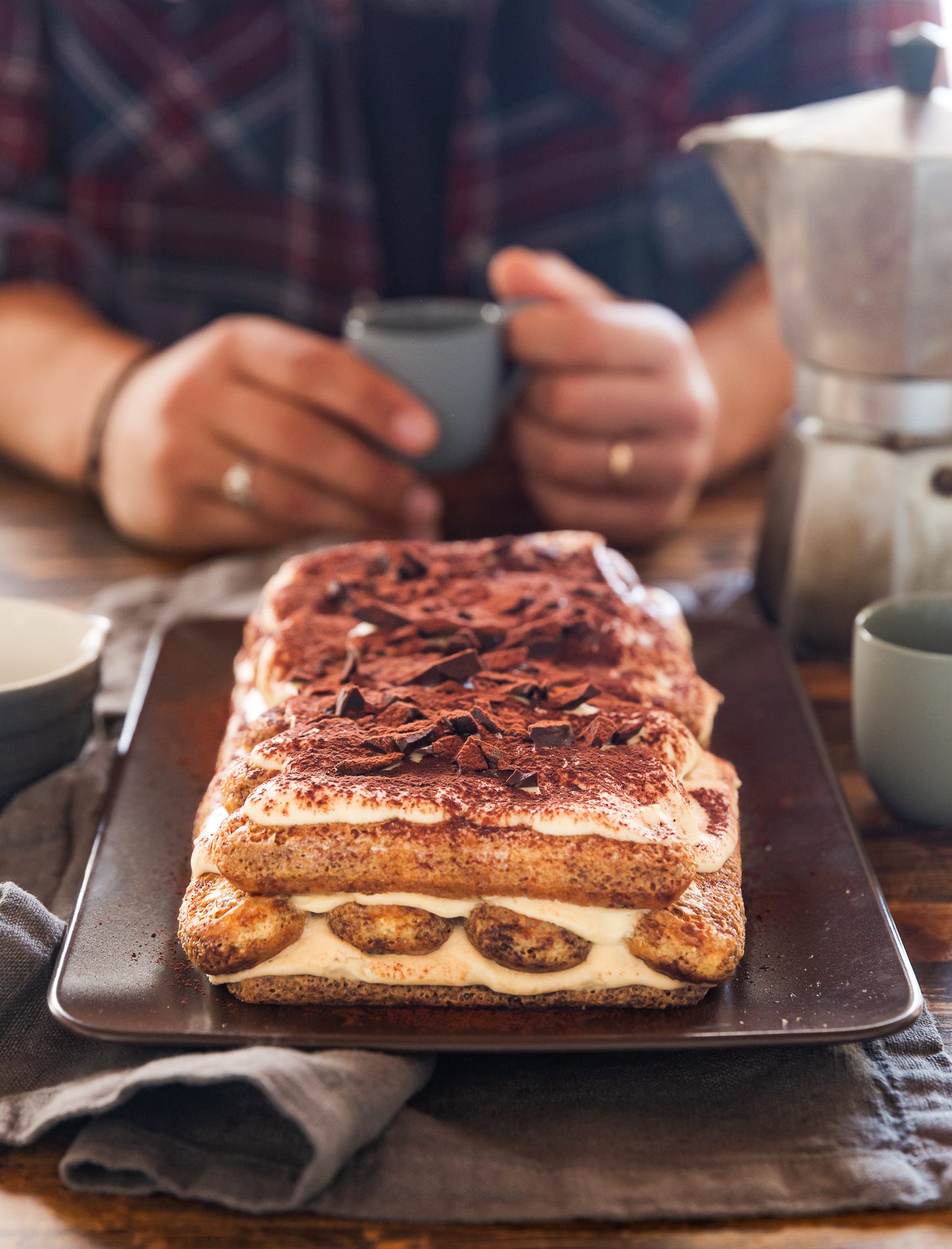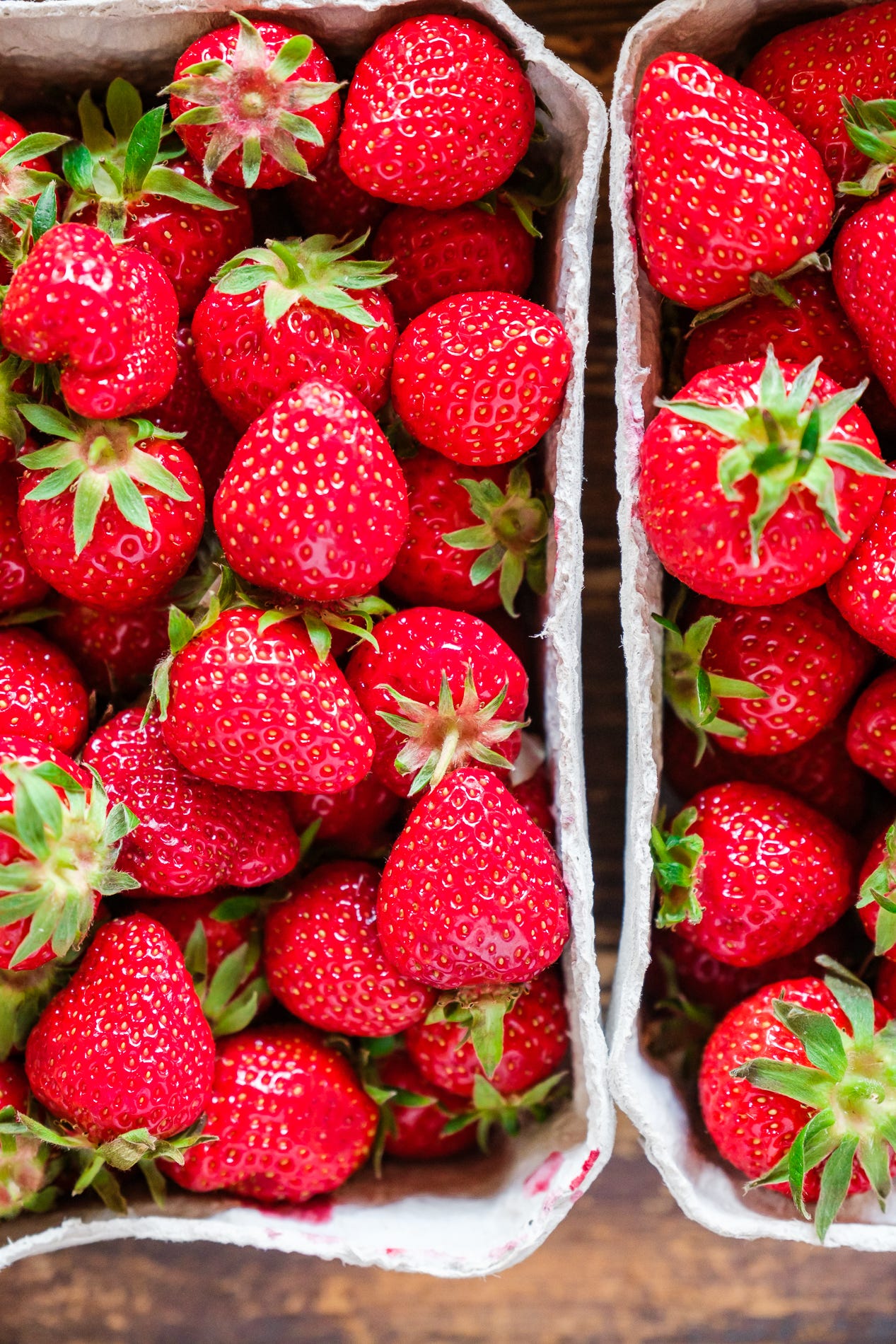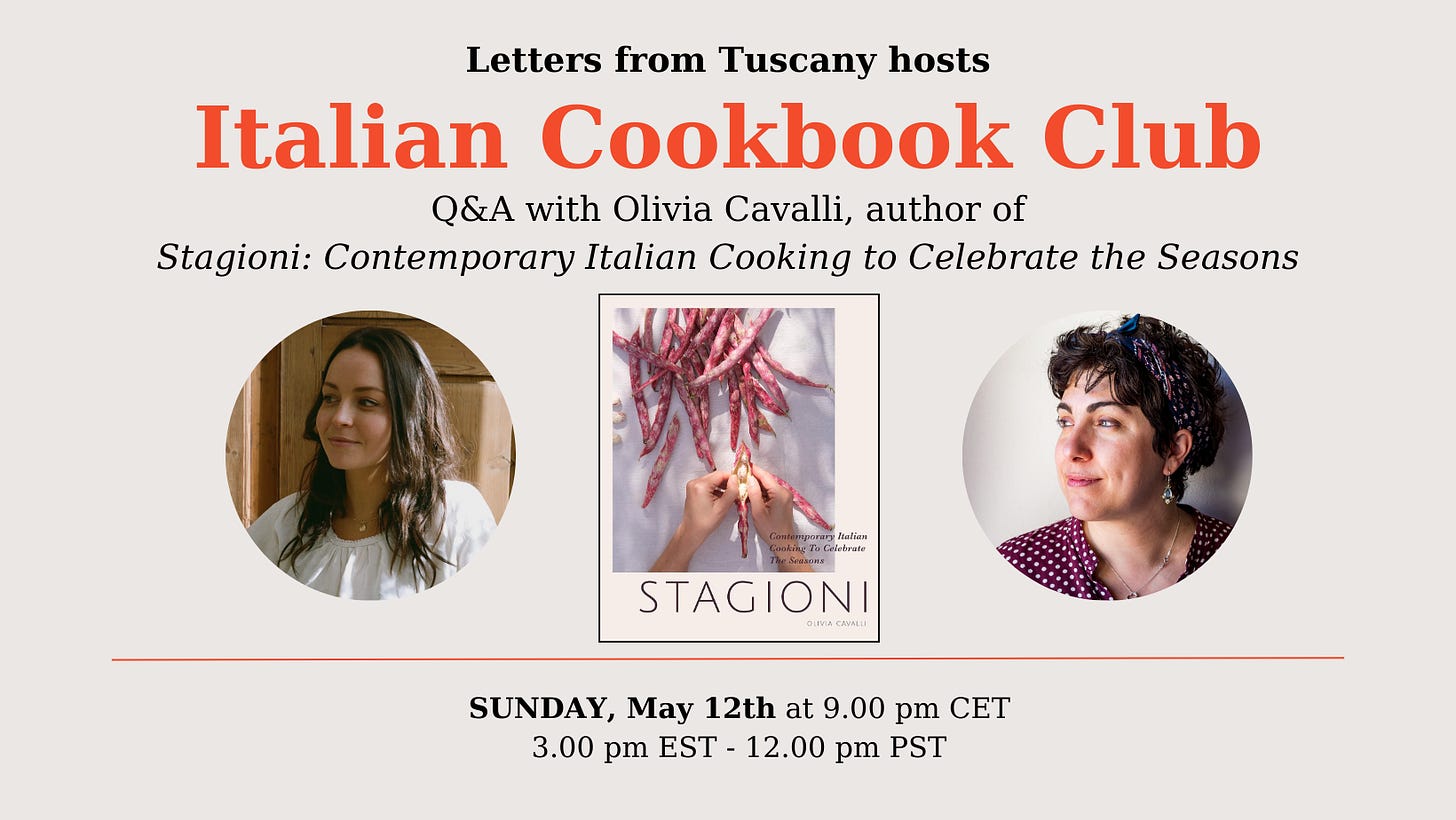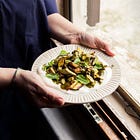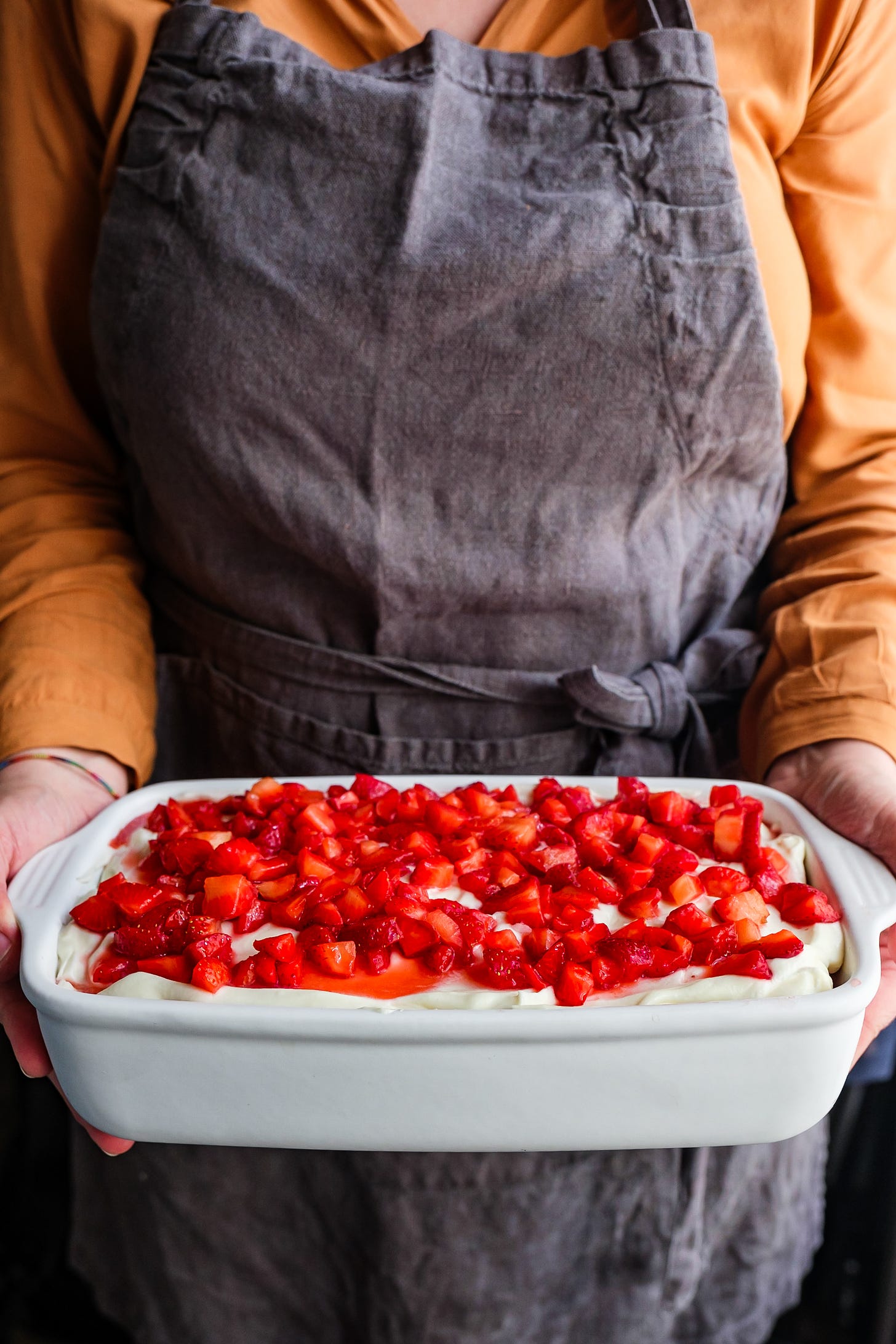Strawberry Tiramisù, an instant summer classic
and why Italian cuisine doesn't have to have Medieval or Renaissance origins every time
In one of the cookbooks on Sienese desserts that crowd my bookshelf, among traditional sweet treats like pan co’ santi and panforte, you can spot a recipe for tiramisù. It boasts a connection with the Medici family, claiming that it was created in Siena in the XVII century during a visit of the Grand Duke Cosimo III de Medici. Fun, but honestly just a bit too stretched.
If you search online for the history of tiramisù, among very imaginative origins, it seems it all stemmed in the ‘60s from the sbatudin, a poor and energetic peasant dessert made of egg yolks whipped with sugar, intended mainly for children, the elderly and convalescents. My grandma has still vivid memories of this uovo sbattuto (literally beaten egg), as they called it here in Tuscany, something she despised with all her heart as a child, leaving in her a durable aversion for raw eggs and their sulfurous smell.
Even though they point the invention of tiramisu to the restaurant Alle Beccherie by the pastry chef Roberto Loli Linguanotto in Treviso—who combined his childhood memories of sbatudin with his previous experience in Germany where spoon desserts were very common—, tiramisù became the well-known and much loved Italian dessert in the ‘70s and ‘80s.
This is when it became a staple of Italian households, a favorite of mothers and grandmothers who would make tiramisù into their domestic baking dishes. It happened thanks to three important factors: supermarkets, refrigerators, and tv commercials. How can you make tiramisù if you do not have access to a supermarket where you can buy mascarpone cheese and the right cookies—Savoardi or Pavesini, even though I am definitely team savoiardi—, maybe of that specific brand advertised on tv with the first commercials during Carosello? How can you keep it cold if you do not have a fridge to stash it into?
(Topo Gigio Carosello advertising for Pavesini, 1963)
I love to tell this story during my cooking classes.
It removes some of the glorious halo from the Italian cuisine, and makes it more approachable, and even a bit more likable and fun, I dare say.
What makes the Italian cuisine appreciated worldwide is not only the long history—which is more often a legend or a marketing expedient—, but a clever use of the freshest ingredients, where the winning principle is less is more.
It doesn’t matter if tiramisu can’t flaunt Medieval or Renaissance origins, or if it was born in the home kitchens of Italian mothers and grandmothers who used their old baking dishes to make a vat of this creamy dessert for their kids and grandkids. Tiramisù is one of the most loved and recognized Italian desserts—among Italians and tourists alike—for one simple reason: it’s delicious.
Tiramisù was a fixture of birthdays and family gatherings for all my childhood and teenage years. I used to open the fridge searching in the cold light for the tray where the remaining tiramisù was waiting just for my greedy spoon. You could see the exposed layers: the thick dusting of cocoa powder, then the silky mascarpone cream, shards of dark chocolate, and savoiardi soaked in unsweetened coffee. I would drive my spoon past the dusting of cocoa powder through the layers, searching for a pool of mascarpone cream. One spoon, two spoons, three spoons: an instant gratification, cold and silky, the contrast of the sweet, creamy mascarpone and the bitter taste of chocolate and coffee on my tongue.
Tiramisù remained my favorite desserts for years, my first choice in restaurants—even after a lavish dinner—, my most common answer to the question “what will you bring?”, a sort of magic wand that would open me the doors to parties and new friendships at university.
What is tiramisù for you? A favorite dessert? An overrated Italian classic? Do you have a family recipe for it? Or a cherished memory of the first time you brought a spoonful of tiramisù to your lips?
Today I’m sharing with you not the classic recipe for the regular coffee tiramisù—I bet everyone has recipe for that—, but my recipe for strawberry tiramisù, something I’ve been making very often in recent years during my Spring and early Summer cooking classes.
Tiramisù is also one of the foods I’m truly missing now that I’m eating dairy free (you can read here why), something I’m still trying to replace it somehow. So for the moment all my strawberries end up on top of my olive oil cake.
Before we jump to the recipe—that you will find below the folder for paid subscribers—a quick remainder of Sunday’s live event!
SUNDAY, May 12th at 9.00 pm CET - 3.00 pm EST - 12.00 pm PST for a live talk with Olivia Cavalli. The live event is open to everyone! She will share her experience as a private chef and food writer, and we will talk about seasonality, Italian food, and the similarities between Italian and British approaches to food and recipes. I can’t wait!
Click here to join the live talk
(A recording of our talk will be available for paying subscribers on Monday)
Let me know if you will be there!
[MARK YOUR CALENDAR] The Next Cook Alongs will be:
SUNDAY, May 12th at 9.00 pm CET - 3.00 pm EST - 12.00 pm PST - Live talk with Olivia Cavalli
Sunday, MAY 19th at 9.00 pm CET - 3.00 pm EST - 12.00 pm PST
Sunday, JUNE 23rd at 9.00 pm CET - 3.00 pm EST - 12.00 pm PST
RECIPE - TIRAMISÙ ALLE FRAGOLE, STRAWBERRY TIRAMISÙ
If a tiramisù and the lemon and sugar marinated strawberries of my childhood had a baby, it would be this strawberry tiramisù.
Don’t imagine this strawberry tiramisù to be overly sweet, though. The lemon juice that you’ll use to marinade the strawberries balances the sweetness of the mascarpone cream, turning it into a fresh summer dessert you’ll want to make on repeat through the season. And it is not just me saying this, as this has been the comment I received more often during the recent cooking classes for the Female Foodie Italian Tours and Bake from Scratch Italian Baking Retreats: this is a winner, an instant summer classic.




